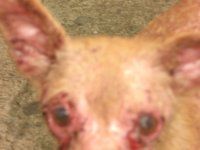Source: www.pet-grub.com
If you wish to quickly print this entire book with the greatest of ease, please read the following page:
Are Antibiotics Making Your Pet Sick?
Sponsored Links
In March, 1997, I published my last article about antibiotics.
Diarrhea, abdominal pain, severe inflammation of the colon (colitis), irritable bowel syndrome, skin problems, fever, elevated white blood cell count, weak immune system, vomiting, dehydration, potassium deficiencies, allergies, colon perforation, bad breath, excess stomach gas, yeast problems, nutritional deficiencies and constipation are just some of the many side effects and problems linked to antibiotics.
In 1928, when Alexander Glemming discovered antibiotics, everyone was raving at this incredible breakthrough in medicine. However, over the years, this breakthrough which was heralded with curing disease is now creating disease and problems of its own.
Bacteria now has built resistance to many antibiotics. Hence, stronger and stronger antibiotics are needed to do the job and if weaker antibiotics create problems, can you imagine what more powerful antibiotics will do?
It's a vicious circle because ultimately bacteria will build resistance to the new and more powerful antibiotics too!
New forms of bacteria and disease are being created. These new problems are very dangerous and the flesh eating disease is the best example of antibiotic resistant bacteria.
Antibiotics literally means against life (anti = against and biotic = life). In a healthy body, there is both good and bad bacteria in the intestinal tract. There should be about 80% good bacteria and about 20% bad bacteria.
When antibiotics are used, both good and bad bacteria are destroyed in the intestinal tract. Once the antibiotics are stopped, the bad bacteria grows back first and faster. The result is a very unhealthy and weak body with no friendly bacteria.
It takes on average 1 year to recover from antibiotics if you are feeding good food and supplementing with friendly bacteria. If the diet you are feeding is bad, then your pet will take even longer to recover and may never fully recover.
The funny thing is that antibiotics relieve symptomatic problems. But after the antibiotics are stopped, the symptoms come back. So what happens now? They give more antibiotics.
What's ironic is that antibiotics are then given to help combat the problems that the antibiotics created in the body.
Antibiotics are definitely over prescribed and over used. Antibiotics for example do nothing for a virus and yet are often administered anyway.
Hopefully soon, common sense will prevail and medical practitioners will realize what is happening. But, it is up to you, the people to put pressures on vets to become more careful about their practice of administering antibiotics.
In fact, encourage your vets to learn the alternatives. Make them aware that there are side effects that can no longer ignored.
Before Antibiotics, What Did People Do?
In World War 1, medics put garlic cloves, which have long been acclaimed for their natural antibiotic properties, in the wounds of soldiers. Some use bee propolis which has natural phagocystosis properties. Phagocystosis is the ability to encourage white blood cells to destroy bacteria.
My uncle, who comes from Slovakia, was telling me that in the old country the villagers would let bread go moldy. They would then apply the moldy bread over a wound to prevent infection. Little did these villagers know but they were making their own penicillin.
There are certainly many other natural antibiotics which have no side effects (except bad breath in garlic's case). In general, natural antibiotics only attack bad bacteria and leave the friendly bacteria alone.
Become aware that although antibiotics have helped save many lives, they are not a cure by any means.
An Important Note
It's important to note that there are situations in which one has no choice but to use antibiotics. I believe it is important though to avoid unnecessary use of antibiotics. One can help avoid needing to use antibiotics by building a healthy body with a strong immune system which has its own natural defense system. Depending on the situation, natural antibiotics can be used but if the situation is advanced then you may have no choice but to use pharmaceutical antibiotics in order to save your pet's life... this is the reality of some situations whether we like it or not.
If antibiotics are needed, then many people will give friendly bacteria such as acidophilus while giving the antibiotics. This is done to help replenish some of the good bacteria as quick as it is killed by the antibiotics. If your pet is ever in the situation in which antibiotics were or are needed, then consider giving friendly bacteria for at least 1 year if not longer. You may also want to consult a holistic vet to learn about other things you can do in order to help reduce or minimize the side effects of antibiotics.
Conclusion
- The body should have 80% friendly bacteria and about 20% bad bacteria inside the intestinal tract. After the use of antibiotics, the body will have no more than 20% friendly bacteria and 80% bad bacteria if not more.
- Most illness, disease and problems begin in the intestinal tract. Thus, antibiotics create the potential for serious illness to begin.
- You may not be giving your pet antibiotics, but if it has ever eaten foods with preservatives, you have been giving your pet what I call 'hidden antibiotics'. The job of preservatives is to control bacteria and once your pet eats food with preservatives, it will ultimately have an effect inside the intestinal tract too and kill the friendly bacteria.
- You should expect it will take at the very least 1 year to recognize the intestinal tract with friendly bacteria after the use of antibiotics.
- Re–colonize the intestinal tract with friendly bacteria by using supplements and feeding natural foods.
- Although antibiotics can cause potential health problems, there are times in which one will have no choice but to use antibiotics in order to save the life of their pet.
More Articles
While I have written any more articles since this one, I do continue to write but instead writing on a specific subject, I do a question and answer section. But before looking at my question and answer section, you might want to read articles written by Dr. Swift, DVM. You will find many articles on numerous topics that might be of interest to you.
 Meet Jumbo, the participant in
Meet Jumbo, the participant in 